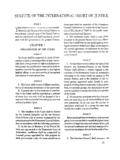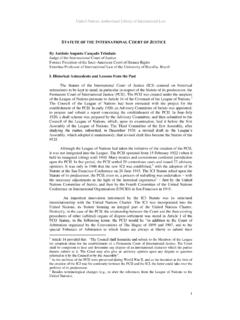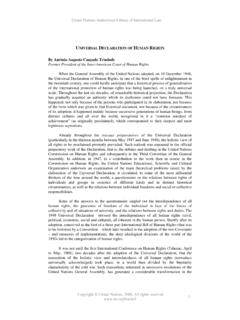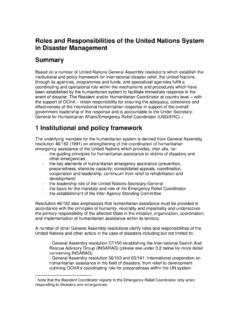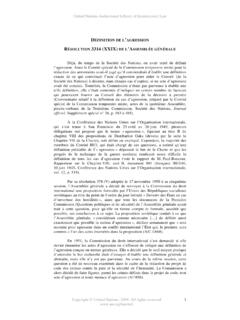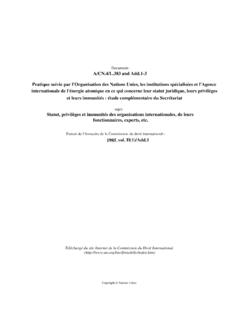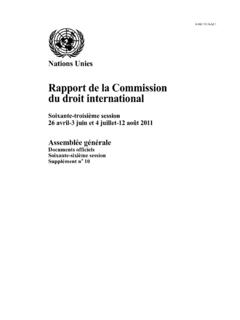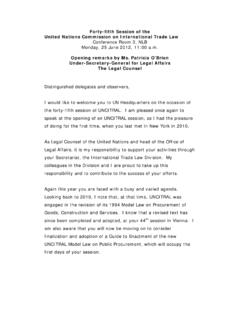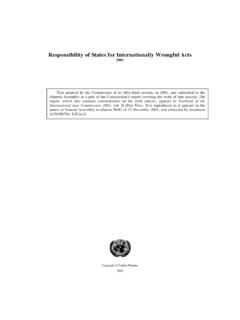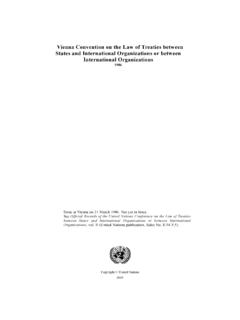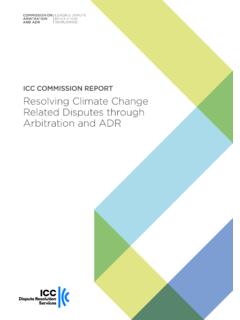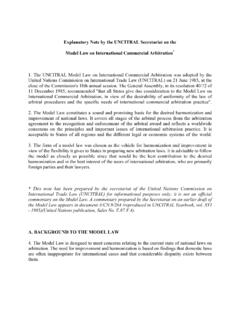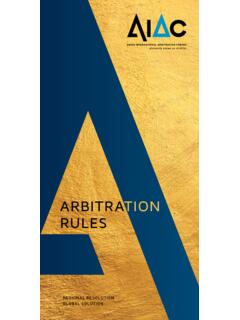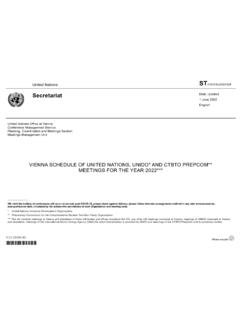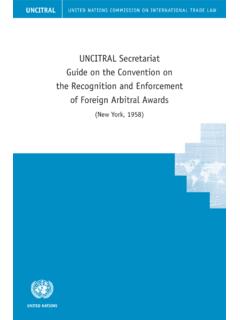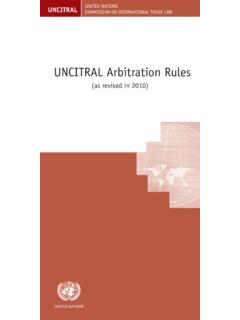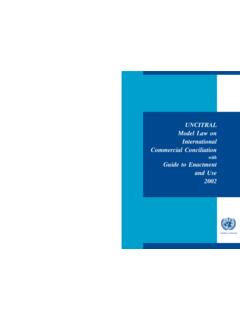Transcription of THE UNITED NATIONS CONVENTION ON
1 THE UNITED NATIONS CONVENTION ON CONTRACTS FOR THE INTERNATIONAL SALE OF GOODS ( CISG ), LECTURE I: PURPOSES, BACKGROUND, HISTORY, NATURE, SCOPE AND APPLICATION Harry M. Flechtner Professor of Law University of Pittsburgh ( ) I. The CISG: the most successful commercial law treaty in history. 1. To date, ratified, approved or acceded to by 71 States representing extraordinary economic, geographic and cultural diversity. 2. These 71 Contracting States account for well more than two-thirds of global trade. II. The Purpose and Approach of the CISG A. The purposes of the CONVENTION are to contribute to the removal of legal barriers in international trade and promote the development of international trade (Preamble to the CISG).
2 B Means to these ends: establishing uniform rules which govern contracts for the international sale of goods and take into account the different social, economic and legal systems (Preamble to the CISG emphasis added). 1. Specifically, the CONVENTION contains rules of substantive law governing the rights and obligations of parties to contracts for the international sale of goods , international private law, addressing such matters as the conclusion of a contract for sale, the seller s obligation to deliver, the quality of goods required, the buyer s obligation to pay, remedies for breach, exemption from liability based on unforeseen circumstances (force majeure), and the like.
3 Significant substantive aspects of the CISG are addressed in Lecture II. 2. As the Preamble indicates, the CONVENTION s rules are intended to embody an international consensus on acceptable sales rules, reflecting the economic, social and legal diversity of the world community. 3. Perhaps even more fundamentally, the CONVENTION s rules, as the Preamble indicates, are intended to be uniform in all States that become parties to the CISG (and even in States that do not). III. Background: the choice of law issue in international sales transactions. 1A. Before the advent of the CISG (and still, when it does not apply), parties to every international sale had to face the question: what law applies to this transaction?
4 The answer would most likely be, the domestic sales law of one of the parties. B. Resulting transactions costs uncertainty as to the applicable law, one party at a disadvantage by having to work with foreign law, opportunistic behavior (race to the courthouse), bargaining costs, otherwise beneficial exchanges lost over disagreements on the issue. IV. History: the advantages of eliminating or at least ameliorating the choice of law issue have long been recognized. A. One approach standardize choice of law rules (Principles of Private International Law) on an international basis by treaty. 1. The Hague CONVENTION on the Law Applicable to International Sales of Goods (1955) (see ) 2.
5 Does not address all the problems/transactions costs noted above. B. Alternative approach standardize substantive sales rules on an international basis by treaty. 1. The idea is to create a uniform international sale law regime familiar to and accepted by the international commercial community, and thereby address more of the problems of the choice-of-domestic-law approach. C. Work on the substantive international sales law approach was taken up by UNIDROIT (International Institute for the Unification of Private Law) in the 1930 s. 1. After interruption by World War II, the work culminated in 1964 in the approval of two companion conventions containing substantive law for international sales transactions: The Uniform Law on the Formation of Contracts for the International Sale of Goods ( ULF ) dealt with issues of contract formation; the Uniform Law for the International Sale of Goods ( ULIS ) dealt with the parties rights and obligations once an international sales contract was formed.
6 2. These conventions were ratified by and entered into force in nine States (mostly, but not entirely, Western European States), but by the late 1960 s it was clear the treaties would not attract the broad acceptance required to achieve their purposes. 2 D. The processes of uncitral offered the prospect of producing a uniform international sales law text that could achieve widespread acceptance by countries representing the range of global economic, social and cultural conditions, and the work of producing such a text was taken up by it in 1969. 1. The Working Group established by uncitral started with the texts of ULF and ULIS, and produced a draft of a single unified substantive sales law CONVENTION that combined rules on contract formation as well as the rights and obligations of parties to a formed international sales contract.
7 2. In 1980 a diplomatic conference was convened in Vienna with participation by a diverse group of 62 States and contributions from important non-governmental organizations that focus on international commercial law. 3. At the diplomatic conference, after extensive discussion and not insignificant modification to the draft text, the final text of the CISG was unanimously approved, and the CONVENTION was opened for signature and ratification by individual States. 4. By late 1986 the requisite number of States had ratified the CISG, and it went into force in 11 States on 1 January 1988. 5. Since that time the CONVENTION has continued to attract adherents.
8 As noted earlier, 71 States are currently party to the CISG, which has been the governing law in many thousands of transactions involving billions of dollars in goods. The Contracting States constitute an extraordinarily diverse group of NATIONS large and small, developed and developing, with domestic economies that are market-oriented and government-directed, located on every inhabited continent, and with a remarkable variety of legal, linguistic, political and cultural traditions. a. Up-to-date ratification information, including information on declarations/reservation that Contracting States have made, is available on the uncitral website at V. The CISG s sphere of application (Article 1(1)).
9 A. The CONVENTION applies to transactions that meet three requirements. 1. The transaction must constitute a contract (or an allegedly-formed contract) for the sale of goods; thus contracts for services or for the sale of 3 property other than goods are not governed by the CISG. a. Goods (not defined in the CONVENTION ) encompass tangible property capable of delivery. The term thus excludes real estate and purely intangible rights, but includes, , raw materials, commodities, finished goods, machinery, i. Sales of goods to be manufactured or produced (specially-manufactured goods) are within the scope of the CISG unless the party who orders the goods undertakes to supply a substantial part of the materials necessary for such manufacture or production (Article 3(1)).
10 Ii. In the case of contracts entailing both the supply of goods and the provision of services (so-called hybrid sale- service contracts), the CONVENTION will not apply if the preponderant part of the obligations of the party who furnishes the goods consists in the supply of labour or other services (Article 3(2)).
